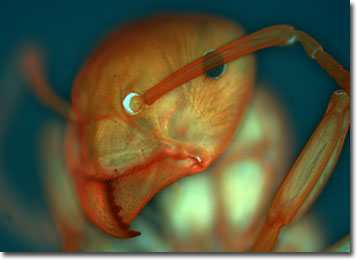Fluorescence Digital Image Gallery
Ant (Formicidae)
Ants are one of the most successful groups of insects to inhabit the Earth during the past 100 million years. All ants belong to the insect family Formicidae in the order Hymenoptera, the same order comprising bees and wasps, and are believed to have descended from a wasp-like ancestor. Scientists have classified 252 living genera of ants.

Ants are distributed throughout the world but are most common in hot climates. It is estimated that there are over 20,000 different species of ants, most of which have yet to be classified. Termites, though similar in appearance to ants, are not related. They belong to the order Isoptera and are believed to be more closely related to cockroaches.
The social behavior of ants, which exhibit a predominately female society made up of three castes, is one of the most complex of the insects. At the heart of each ant colony is the queen, a winged, fertile female responsible for laying all of the eggs. Infertile females, called workers, gather food, protect the nest and queen, and tend to the larvae and pupae. Males generally have wings and are hatched along with new queens for the sole purpose of fertilizing them, dying soon thereafter.
Ants are capable of carrying objects up to 50 times their weight, equivalent to a human carrying a car. Two of the most dangerous groups, the army ants and driver ants, are found in South America and Africa, respectively. These ants swarm in groups of 10,000 to over a million in search of food and destroy anything in their path. They have even been known to kill large animals, as big as a horse, that are unlucky enough to cross their deadly path.
The specimen presented here was imaged with a Nikon Eclipse E600 microscope operating with fluorite and/or apochromatic objectives and vertical illuminator equipped with a mercury arc lamp. Specimens were illuminated through Nikon dichromatic filter blocks containing interference filters and a dichroic mirror and imaged with standard epi-fluorescence techniques. Specific filters for the ant specimen were a UV-2E/C, B-2E/C, and a Y-2E/C. Photomicrographs were captured with a Nikon DXM 1200 digital camera system coupled to the microscope with a lens-free C-mount adapter.
BACK TO THE FLUORESCENCE DIGITAL IMAGE GALLERY
